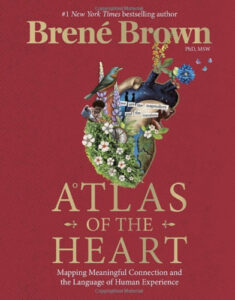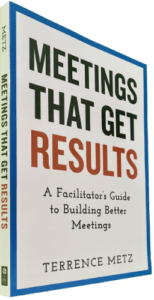Dr. Brené Brown’s book on emotions, “Atlas of the Heart” (Mapping Meaningful Connections and the Language of Human Experience), was our most flagged book of 2022. Undoubtedly, here’s why…
And why you, as a leader and facilitator, should read it.

Atlas of the Heart builds around the fact that the average American can only identify three emotions: mad, sad, and glad. Since her team studied more than seventy emotions, Brené Brown makes it clear that understanding emotive states is as important as knowing physically where you are or where you’re going. Significantly, people everywhere, are seeking meaningful connections.
Indeed, poor or inaccurate vocabulary (rhetorical precision) challenges most people to understand or explain what they are feeling. Similarly, when meeting and workshop participants are unable to express how they feel, deliverables and accountability for those deliverables are seriously jeopardized.
For example, a majority of us would have a tough time explaining the difference between despair and grief, or calm and tranquility, but “Atlas” makes the differences clear and easy to understand. Therefore, here is an alpha-sorted table of the emotions that “Atlas” explores:
| Admiration | Defensiveness | Happiness | Pride |
| Amusement | Dehumanization | Hate | Regret |
| Anger | Despair | Heartbreak | Relief |
| Anguish | Disappointment | Hopelessness | Resentment |
| Anxiety | Disconnection | Hubris | Resignation |
| Avoidance | Discouragement | Humiliation | Reverence |
| Awe | Disgust | Humility | Sadness |
| Belonging | Dread | Hurt | Sarcasm |
| Betrayal | Embarrassment | Insecurity | Schadenfreude |
| Bittersweetness | Empathy | Interest | Self-compassion |
| Boredom | Envy | Invisibility | Self-righteousness |
| Boundaries | Excitement | Irony | Self-trust |
| Calm | Expectations | Jealousy | Shame |
| Cognitive Dissonance | Fear | Joy | Stress |
| Comparative Suffering | Fitting In | Loneliness | Surprise |
| Comparison | Flooding | Love | Sympathy |
| Compassion | Foreboding Joy | Lovelessness | Tranquility |
| Confusion | Freudenfreude | Nostalgia | Trust |
| Connection | Frustration | Overwhelm | Vulnerability |
| Contempt | Gratitude | Paradox | Wonder |
| Contentment | Grief | Perfectionism | Worry |
| Curiosity | Guilt | Pity |
Why You Should Care About Meaningful Connections
Whereas effective meetings rely on clear expression, “Atlas” opens with a quotation from Rumi indicating the importance of language to express oneself.
Heart is sea,
language is shore.
Whatever sea includes,
will hit the shore.
While I encourage you to add this book to your library, both as a reference and as an excellent ‘loaner,’ here are eleven “facilitator’s highlights.” In particular, she stresses references or definitions indicating the vital role that language provides to advance consensual understanding by sharing our emotions. Therefore, we all know that clarity and sharing are significant keystones of effective meetings and workshops.
Language and Facilitating Meaningful Connections
Brené Brown begins by touting the importance of language as the primary portal to meaning—allowing connections, learning, and increased awareness. Thus, having access to the right words (read: rhetorical precision) “opens up universes.” Furthermore, each of us contains a unique vocabulary that helps explain why no one is as smart as everyone.
“Without accurate language, we struggle to get the help we need, we don’t always regulate or manage our emotions and experiences in a way that allows us to move through them productively . . . Language shows us that naming an experience doesn’t give the experience more power, it gives us the power of understanding and meaning.”
Painting DONE
While the Agile mindset calls it DONE, business consultants call it a “deliverable.” Steven Covey concurs with his expression, “Start with the end in mind.” Likewise, Brené Brown asks her research staff and team to “paint done.” Markedly, she brings the “right to left” thinking component of our curriculum to life by describing the importance of “painting done.” Also, her method requires visual details as someone is walking her through the expectations of what the completed task will look like, when it will be done, how it will be used, the overall context, and the consequences of not doing it.
Highlighted Emotions When Facilitating Meaningful Connections
Frequently observed in meetings and workshops, the following emotional states have been selected for your review and consideration. Assuredly, “removing distractions” remains the primary rule for all facilitators. However, the following emotions cause noise and distraction, working against the traction you seed to develop among your meeting and workshop participants. Additionally, the highlighted emotions are alpha-sorted so as not to place a stronger emphasis on one over others.
Anger
Anger might not be an emotion. Rather, it is a reflection (symptom) or intensification of many potential emotional causes. Many times, people feel better simply by sharing and talking and getting things “off of their chest.” Use Brené Brown’s book when you want a clearer understanding of the following causes of anger:
- Anxiety
- Confusion
- Depression
- Fear
- Frustration
- Grief
- Guilt
- Helplessness
- Humiliation
- Hurt
- Isolation
- Jealousy
- Loneliness
- Outrage at injustice
- Overwhelming stress
- Rejection
- Sadness
- Shame
Belonging vs. Fitting In
Like earlier Best Practices articles and arguments about the crucial difference between being “nice” and being “kind.” Here are explanations discovered by other experts based on her extensive research:
- Belonging is being somewhere where you want to be, and they want you.
- Fitting in is being somewhere where you want to be, but they don’t care one way or the other.
- Belonging is being accepted for you 🙂
- Fitting in is being accepted for being like everyone else.
- “If I get to be me, I belong. If I must be like YOU, I fit in.”
Confusion
When confusion persists, it’s clearly one of the most valuable times to benefit from a professional facilitator. Confusion is vital to learning, it motivates and triggers problem-solving. When confused, we typically engage in more careful deliberation. Brené Brown refers to a Fast Company article by Mary Slaughter and David Rock with the NeuroLeadership Institute who claim that to be effective, learning needs to be effortful. Liken it to a muscle ‘burn’ when the muscle is being strengthened. The brain needs to feel some discomfort for deep learning.
Connection (a synonym for love)
Brené Brown defines ‘love’ as the energy that exists between people when they feel seen, heard, and valued; when they can give and receive without judgment; and when they derive sustenance and strength from the relationship. We’re a social species (see Hurari’s “Sapiens”) and that’s why meaningful connections matter.
She stresses that connection is why shame can be so painful and debilitating. We’re wired to be connected, and shame weakens our connections. Note the importance of feeling connected based on her research:
- Living with air pollution increases the odds of dying by five percent.
- Living with obesity—twenty percent.
- Loneliness—45 percent.
Love is defined as “the preoccupying and strong desire for further connection, the powerful bonds people hold with a select few and the intimacy that grows between them, the commitment to loyalty and faithfulness.” Love forms the emotional context from which to strengthen relationships. Strong relationships are an integral part of all high-performance teams.
Google’s research proved that the one characteristic among high-performance teams is the tendency to distribute airtime equally among all participants (i.e., how much time each person talks).
Contempt
Contempt says “I’m better than you. And you are lesser than me.” Today, in the USA, Democrats and Republicans think that each side is driven by benevolence while the other side is evil and motivated by hatred; therefore, an enemy with whom one cannot negotiate or compromise. Identical to the situation among diverse cultures and religions in the Middle East.
According to Arthur Brooks, we don’t need to disagree less, but we need to learn how to disagree better—without contempt and cruelty. We need to replace negative communication patterns with respect and appreciation. A talented facilitator will use ‘challenge’ and ‘discovery’ to surface the driving reasons or rationale behind contempt.
Empathy
Empathy is a tool of compassion, “an emotional skill that allows us to understand what someone is experiencing and to reflect that understanding. Empathy improves interpersonal decision-making because it “facilitates ethical decision-making and moral judgments.” It has been proven to enhance well-being, strengthen relational bonds, and allow people to improve how others see them.
“Empathy is a tool of compassion. We can respond empathically if we are willing to be present to someone’s pain. If we’re not willing to do that, it’s not real empathy.”
Brené Brown focuses on data that surfaces from her research when sourcing Theresa Wiseman’s attributes of empathy:
- Staying out of judgment: Just listen, don’t apply value.
- Recognizing emotions: How can I touch within myself something that helps me identify and connect with what the other person might be feeling?
- Communicating our understanding and confirming its accuracy.
- Perspective taking: What does that concept mean for you? What is that experience like for you?
- Practicing mindfulness (see Kristin Neff).
You may also take a self-compassion inventory at www.self-compassion.org.
Humility
Facilitators should remain humble and exude humility. Humility is not downplaying yourself or your accomplishments. That describes modesty. Humility is not thinking less of yourself, it is thinking of yourself less often.
Joy
The opposite of joy is not sadness, but fear. And FEAR is known to be an acronym for “F#@! everything and run.” FEAR implies a FUD factor that professional facilitators must eliminate or diminish; namely Fear, Uncertainty, and Doubt.
Sadness
According to Brené Brown, one of the causes of “human beings engaging in all kinds of cognitive gymnastics aimed at justifying their behavior,” is sadness. Although many have proven the benefits of happiness, sadness provides benefits as well, according to Joseph Gorgas from Australia.
“Sad people are less prone to judgmental errors, are more resistant to eye-witness distortions, are sometimes more motivated, and are more sensitive to social norms. They can act with more generosity too.”
Even Daniel Kahneman would agree, that a group of sad participants will outperform a group of over-confident participants. Think about it, if we are not sad about something, then why have a meeting?
Surprise
Here we find the shortest-duration emotion. Brené Brown describes ‘surprise’ as a bridge between cognition and emotion, rarely lasting more than a few seconds. Although other experts claim a strong relationship between surprise and unexpectedness, she claims surprise is an emotion, but unexpectedness is a cognitive reaction. To improve our understanding of the differences, she references Think Again: The Power of Knowing What You Don’t Know by Wharton professor Adam Grant.
Tranquility
Seek contentment, not tranquility. Here is the difference between being content and feeling tranquil. With contentment, we often have the sense of having completed something. With tranquility, we relish the feeling of doing nothing.
Summary
Professional facilitators do not ignore emotions, they leverage them. Our goal is not to eliminate participant feelings but to harness them in a way that develops a deliverable that everyone promises to accept and support.
______
Don’t ruin your career by hosting bad meetings. Sign up for a workshop or send this to someone who should. MGRUSH workshops focus on meeting design and practice. Each person practices tools, methods, and activities daily during the week. Therefore, while some call this immersion, we call it the road to building high-value facilitation skills.
Our workshops also provide a superb way to earn up to 40 SEUs from the Scrum Alliance, 40 CDUs from IIBA, 40 Continuous Learning Points (CLPs) based on Federal Acquisition Certification Continuous Professional Learning Requirements using Training and Education activities, 40 Professional Development Units (PDUs) from SAVE International, as well as 4.0 CEUs for other professions. (See workshop and Reference Manual descriptions for details.)
Want a free 10-minute break timer? Sign up for our once-monthly newsletter HERE and receive a free timer along with four other of our favorite facilitation tools.
Go to the Facilitation Training Store to access proven, in-house resources, including fully annotated agendas, break timers, and templates. Finally, take a few seconds to buy us a cup of coffee and please SHARE with others.
In conclusion, we dare you to embrace the will, wisdom, and activities that amplify a facilitative leader. #facilitationtraining #MEETING DESIGN
______
With Bookmarks no longer a feature in WordPress, we need to append the following for your benefit and reference
- 20 Prioritization Techniques = https://foldingburritos.com/product-prioritization-techniques/
- Creativity Techniques = https://www.mycoted.com/Category:Creativity_Techniques
- Facilitation Training Calendar = https://mgrush.com/public-facilitation-training-calendar/
- Liberating Structures = http://www.liberatingstructures.com/ls-menu
- Management Methods = https://www.valuebasedmanagement.net
- Newseum = https://www.freedomforum.org/todaysfrontpages/
- People Search = https://pudding.cool/2019/05/people-map/
- Project Gutenberg = http://www.gutenberg.org/wiki/Main_Page
- Scrum Events Agendas = https://mgrush.com/blog/scrum-facilitation/
- Speed test = https://www.speedtest.net/result/8715401342
- Teleconference call = https://youtu.be/DYu_bGbZiiQ
- The Size of Space = https://neal.fun/size-of-space/
- Thiagi/ 400 ready-to-use training games = http://thiagi.net/archive/www/games.html
- Visualization methods = http://www.visual-literacy.org/periodic_table/periodic_table.html#
- Walking Gorilla = https://youtu.be/vJG698U2Mvo

Terrence Metz, president of MG RUSH Facilitation Training, was just 22-years-old and working as a Sales Engineer at Honeywell when he recognized a widespread problem—most meetings were ineffective and poorly led, wasting both time and company resources. However, he also observed meetings that worked. What set them apart? A well-prepared leader who structured the session to ensure participants contributed meaningfully and achieved clear outcomes.
Throughout his career, Metz, who earned an MBA from Kellogg (Northwestern University) experienced and also trained in various facilitation techniques. In 2004, he purchased MG RUSH where he shifted his focus toward improving established meeting designs and building a curriculum that would teach others how to lead, facilitate, and structure meetings that drive results. His expertise in training world-class facilitators led to the 2020 publication of Meetings That Get Results: A Guide to Building Better Meetings, a comprehensive resource on effectively building consensus.
Grounded in the principle that “nobody is smarter than everybody,” the book details the why, what, and how of building consensus when making decisions, planning, and solving problems. Along with a Participant’s Guide and supplemental workshops, it supports learning from foundational awareness to professional certification.
Metz’s first book, Change or Die: A Business Process Improvement Manual, tackled the challenges of process optimization. His upcoming book, Catalyst: Facilitating Innovation, focuses on meetings and workshops that don’t simply end when time runs out but conclude with actionable next steps and clear assignments—ensuring progress beyond discussions and ideas.



